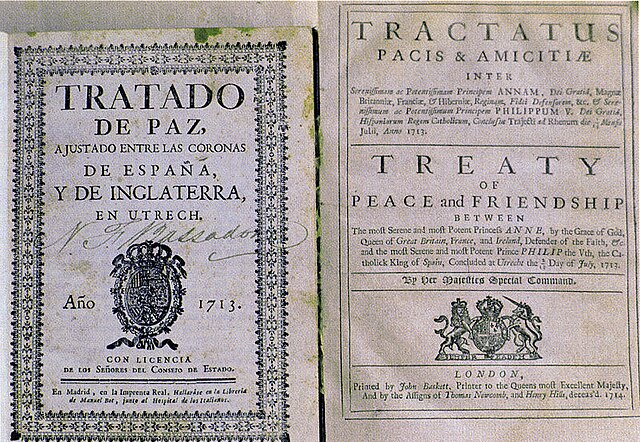The Peace of Utrecht was a series of peace treaties signed by the belligerents in the War of the Spanish Succession, in the Dutch city of Utrecht between April 1713 and February 1715. The war involved three contenders for the vacant throne of Spain, and involved much of Europe for over a decade. The main action saw France as the defender of Spain against a multinational coalition. The war was very expensive and bloody, and finally stalemated. Essentially, the treaties allowed Philip V to keep the Spanish throne in return for permanently renouncing his claim to the French throne, along with other necessary guarantees that would ensure that France and Spain should not merge, thus preserving the balance of power in Europe.
First edition of the 1713 Treaty of Utrecht between Great Britain and Spain in Spanish (left) and a later edition in Latin and English.
Signature of the Treaty of Utrecht between Portugal and Spain, in the Maliebaan, on 6 February 1715. The Dom Tower is visible in the background. From left to right: The Duke of Osuna, in red coat, Luís da Cunha, in black coat, The Secretaries, in blue and yellow coats and the Count of Tarouca, crouched, in brown coat.
Allegory of the Peace of Utrecht by Antoine Rivalz
Ensuring the succession of Maria Theresa reduced Austria's gains from the war, and ultimately led to the War of the Austrian Succession in 1740
War of the Spanish Succession
The War of the Spanish Succession was a European great power conflict fought between 1701 and 1714. The immediate cause was the death of the childless Charles II of Spain in November 1700, which led to a struggle for control of the Spanish Empire. His nominated heir was Philip of Anjou, a grandson of Louis XIV of France, whose main backers were France and most of Spain. His rival, Archduke Charles of Austria, was supported by the Grand Alliance, whose primary members included the Holy Roman Empire, the Dutch Republic, and Great Britain. Significant related conflicts include the 1700 to 1721 Great Northern War, and Queen Anne's War in North America.
Clockwise, from top left: Battle of Blenheim (13 August 1704) Battle of Ramillies (23 May 1706) Battle of Almansa (25 April 1707) Battle of Denain (24 July 1712)
Charles II, 1665–1700, last Habsburg King of Spain
Proclamation of Philip of Anjou as Philip V of Spain, Versailles, 16 November 1700
Francis Rákóczi, leader of the 1703–1711 Hungarian revolt; funded by France, this was a major distraction for Austria








